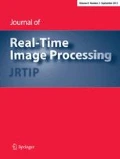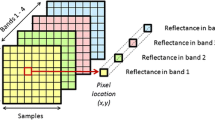Abstract
A challenging problem in spectral unmixing is how to determine the number of endmembers in a given scene. One of the most popular ways to determine the number of endmembers is by estimating the virtual dimensionality (VD) of the hyperspectral image using the well-known Harsanyi–Farrand–Chang (HFC) method. Due to the complexity and high dimensionality of hyperspectral scenes, this task is computationally expensive. Reconfigurable field-programmable gate arrays (FPGAs) are promising platforms that allow hardware/software codesign and the potential to provide powerful onboard computing capabilities and flexibility at the same time. In this paper, we present the first FPGA design for the HFC-VD algorithm. The proposed method has been implemented on a Virtex-7 XC7VX690T FPGA and tested using real hyperspectral data collected by NASA’s Airborne Visible Infra-Red Imaging Spectrometer over the Cuprite mining district in Nevada and the World Trade Center in New York. Experimental results demonstrate that our hardware version of the HFC-VD algorithm can significantly outperform an equivalent software version, which makes our reconfigurable system appealing for onboard hyperspectral data processing. Most important, our implementation exhibits real-time performance with regard to the time that the hyperspectral instrument takes to collect the image data.











Similar content being viewed by others
References
Chang, C.-I.: Hyperspectral Imaging: Techniques for Spectral Detection and Classification. Kluwer/Plenum Academic Publishers, NewYork (2003)
Chang, C.-I., Du, Q.: Estimation of number of spectrally distinct signal sources in hyperspectral imagery. IEEE Trans. Geosci. Remote Sens. 42(3), 608–619 (2004)
Harsanyi, J. C., Farrand, W., Chang, C.-I.: Detection of subpixel spectral signatures in hyperspectral image sequences. In: Proceedings of the American Society for Photogrammetry and Remote Sensing, Annual Meeting, pp. 236–247 (1994)
Patel, A., Kosko, B.: Optimal noise benefits in Neyman–Pearson signal detection. In: IEEE International Conference on Acoustics, Speech and Signal Processing, 2008. ICASSP 2008, pp. 3889–3892, (2008)
Plaza, A., Du, Q., Chang, Y.-L., King, R.L.: High performance computing for hyperspectral remote sensing. IEEE IEEE J. Select. Topics Appl. Earth Observ. Remote Sens. 4(3), 528–544 (2011)
Plaza, A., Chang, C.-I.: High Performance Computing in Remote Sensing. CRC Press, Boca Raton (2007)
Plaza, A., Valencia, D., Plaza, J.: High-performance computing in remotely sensed hyperspectral imaging: the pixel purity index algorithm as a case study. In: Proceedings of international parallel and distributed processing symposium (IPDPS) (2006)
Plaza, A., Plaza, J., Paz, A., Sanchez, S.: Parallel hyperspectral image and signal processing. IEEE Signal Process. Mag. 28(3), 119126 (2011)
Lopez, S., Vladimirova, T., Gonzalez, C., Resano, J., Mozos, D., Plaza, A.: The promise of reconfigurable computing for hyperspectral imaging onboard systems: a review and trends. IEEE Proc. 101(3), 698–722 (2013)
Bernabe, S., Lopez, S., Plaza, A., Sarmiento, R., Rodriguez, P. G.: FPGA design of an automatic target generation process for hyperspectral image analysis. In: IEEE international conference on parallel and distributed systems (ICPADS) 2011, pp. 1010–1015, 7–9 (Dec. 2011)
Lopez, S., Horstrand, P., Callico, G.M., Lopez, J.F., Sarmiento, R.: A novel architecture for hyperspectral endmember extraction by means of the modified vertex component analysis (MVCA) algorithm. IEEE J. Select. Topics Appl. Earth Observ. Remote Sens. 5(6), 1837–1848 (2012)
Gonzalez, C., Mozos, D., Resano, J., Plaza, A.: FPGA impleentation of the N-FINDR algorithm for remotely sensed hyperspectral image analysis. IEEE Trans. Geosci. Remote Sens. 50(2), 374–388 (2012)
Gonzalez, C., Resano, J., Plaza, A., Mozos, D.: FPGA implementation of abundance estimation for spectral unmixing of hyperspectral data using the image space reconstruction algorithm. IEEE J. Select. Topics Appl. Earth Observ. Remote Sens. 5(1), 248–261 (2012)
Gonzalez, C., Resano, J., Mozos, D., Plaza, A., Valencia, D.: FPGA implementation of the pixel purity index algorithm for remotely sensed hyperspectral image analysis. EURASIP J. Adv. Signal Process., article 969806 (2010)
Resano, J., Clemente, J.A., Gonzalez, C., Mozos, D., Catthoor, F.: Efficiently scheduling runtime reconfigurations. ACM Trans. Des. Automat. Electron. Syst. 13(4), 58–69 (2008)
Clemente, J.A., Gonzalez, C., Resano, J., Mozos, D.: A task graph execution manager for reconfigurable multi-tasking systems. Microprocess. Microsyst. 34(2–4), 73–83 (2010)
Sterpone, L., Porrmann, M., Hagemeyer, J.: A novel fault tolerant and runtime reconfigurable platform for satellite payload processing. IEEE Trans. Comput. 62(8), 1508–1525 (2013)
Chang, C.-I., Xiong, W., Wu, C.-C.: Field-programmable gate array design of implementing simplex growing algorithm for hyperspectral endmember extraction. IEEE Trans. Geosci. Remote Sens. 51(3), 1693–1700 (2013)
Quarteroni, A., Sacco, R., Saleri, F.: Numerical Mathematics, 2nd edn. Texts in Applied Mathematics, vol. 37. Springer, New York (2007)
Davidson, C. E., Ben-David, A.: On the use of covariance and correlation matrices in hyperspectral detection. Appl Image. Pattern Recogn. Works. (AIPR), pp. 1–6 (2011)
Acknowledgments
This work has been supported by the by the Spanish Ministry of Science and Innovation under references READAR (TIN2013-40968-P) and DREAMS (TEC2011-28666-C04-04).
Author information
Authors and Affiliations
Corresponding author
Rights and permissions
About this article
Cite this article
Gonzalez, C., Lopez, S., Mozos, D. et al. A novel FPGA-based architecture for the estimation of the virtual dimensionality in remotely sensed hyperspectral images. J Real-Time Image Proc 15, 297–308 (2018). https://doi.org/10.1007/s11554-014-0482-2
Received:
Accepted:
Published:
Issue Date:
DOI: https://doi.org/10.1007/s11554-014-0482-2




